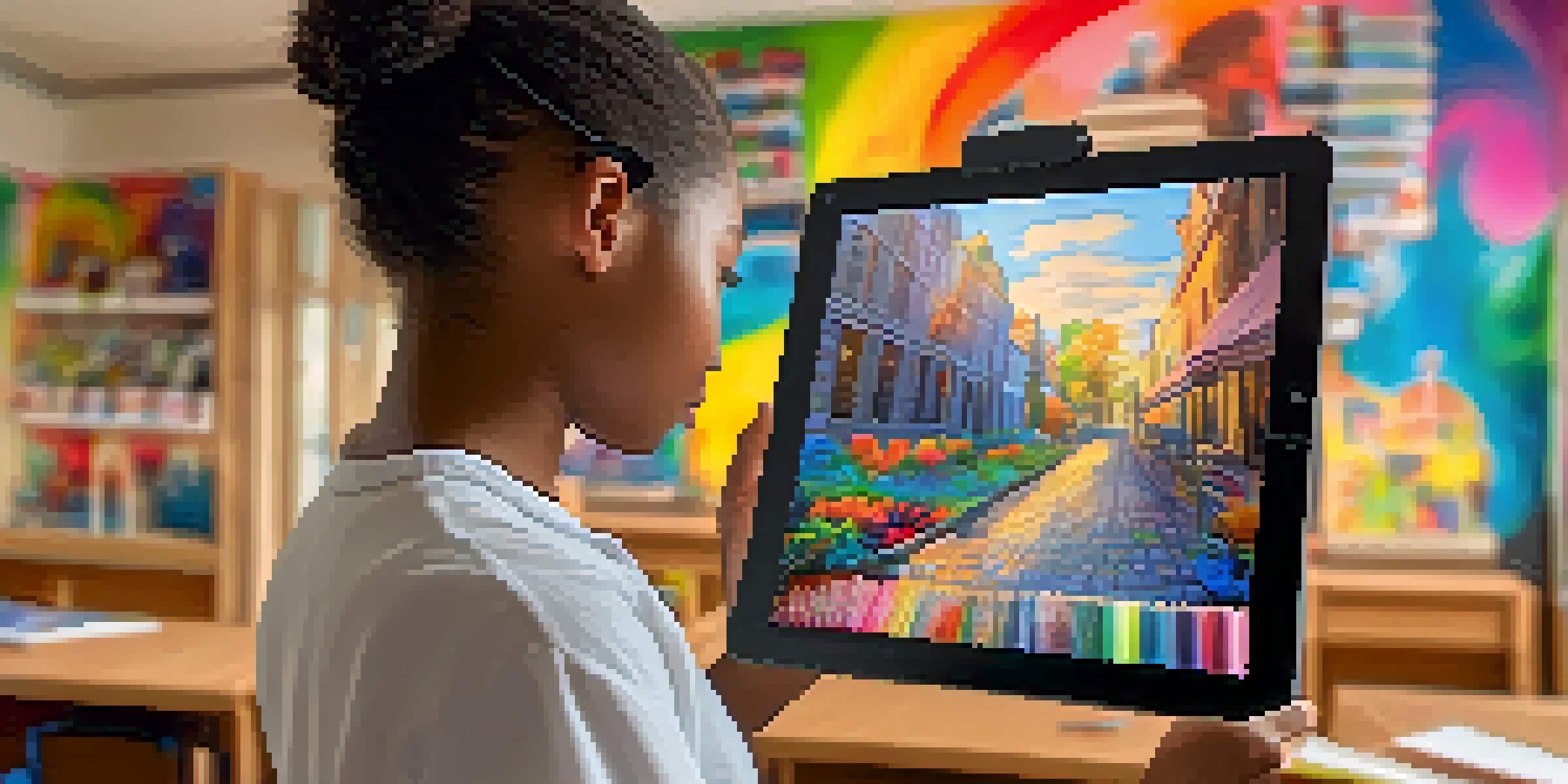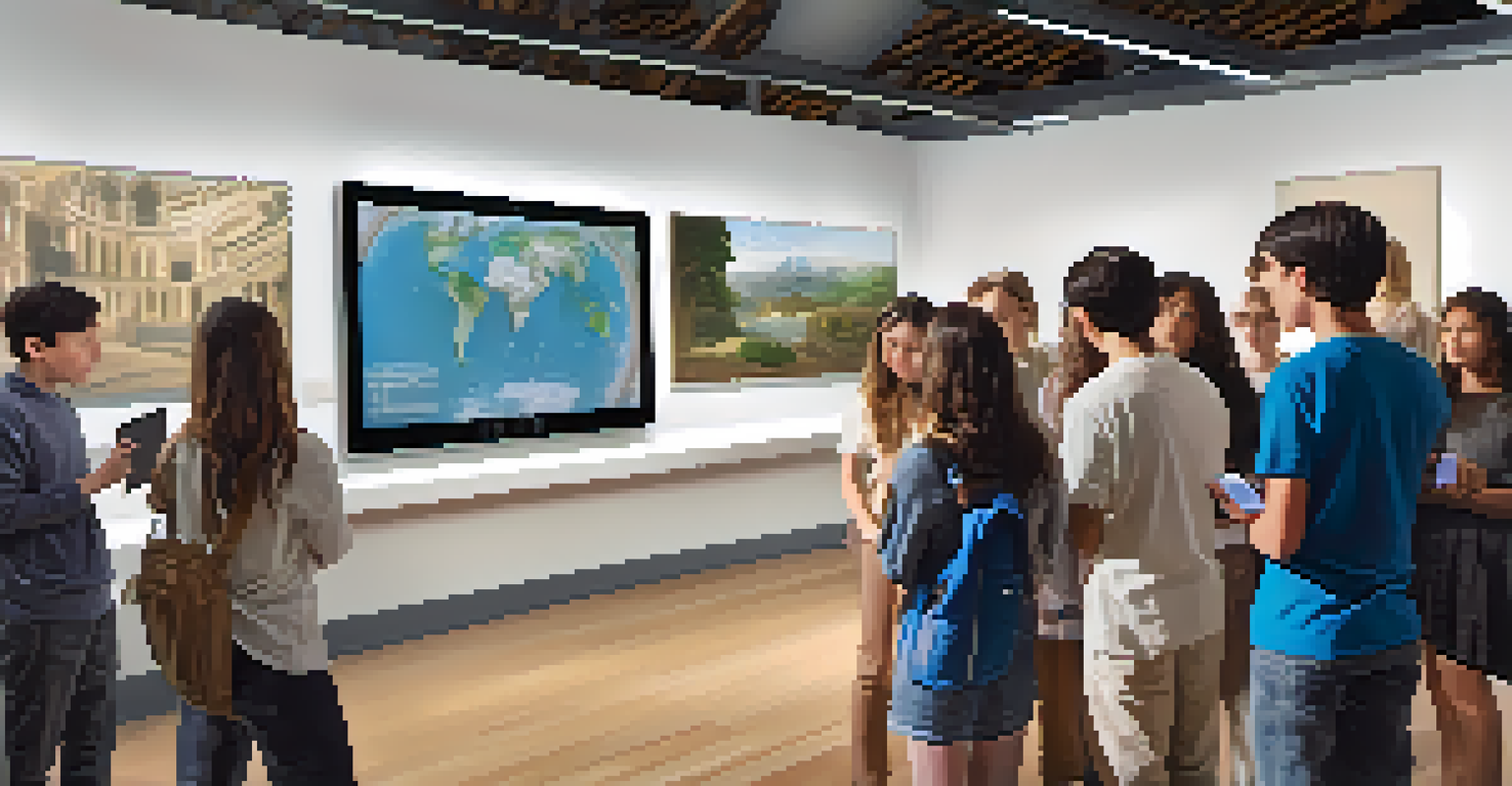Exploring the Use of AR in Art Education

Understanding Augmented Reality in Education
Augmented Reality (AR) blends digital elements with the real world, creating an interactive experience. This technology allows students to engage with art in ways previously unimaginable. By using AR, educators can enhance traditional art lessons, making them more dynamic and immersive.
Technology will not replace teachers, but teachers who use technology will replace those who do not.
For instance, imagine a student standing in front of a famous painting and using their tablet to see the brush strokes come alive. This not only captivates their attention but also deepens their understanding of the artist's techniques. The integration of AR transforms passive learning into an active exploration of art.
Ultimately, AR serves as a bridge between theory and practice in art education. It brings art history to life, enabling students to experience artworks beyond the confines of textbooks. As AR continues to evolve, its role in education is likely to expand, offering new opportunities for creative expression.
Enhancing Artistic Skills Through AR Tools
AR tools provide students with innovative ways to hone their artistic skills. For example, applications that overlay digital brushes and colors onto a physical canvas allow learners to experiment with different styles without the fear of making mistakes. This encourages a spirit of creativity and exploration.

Furthermore, these tools can simulate various art techniques, from watercolor to oil painting, giving students a hands-on understanding of each medium. By practicing virtually, students build confidence before transitioning to traditional methods. This gradual approach demystifies the process of creating art.
AR Enhances Art Education Engagement
Augmented Reality transforms traditional art lessons into interactive experiences, allowing students to actively explore and understand art.
As students engage with these AR technologies, they also develop critical thinking and problem-solving skills. They learn to make decisions about composition, color mixing, and layering in a risk-free environment. The integration of AR thus not only fosters artistic ability but also nurtures essential skills for lifelong learning.
Interactive Learning Experiences with AR
One of the most exciting aspects of AR in art education is the ability to create interactive learning experiences. For instance, virtual museum tours allow students to explore galleries from anywhere in the world. These tours can include detailed information about each piece, giving context that enhances appreciation.
The art of education is the art of assisting discovery.
In addition, AR can facilitate collaborative projects where students can co-create artworks. Using shared AR platforms, they can visualize their ideas in real time, making the creative process more engaging. This not only fosters teamwork but also encourages diverse perspectives in artistic expression.
Such interactive experiences can reinvigorate the art classroom, making lessons more memorable and impactful. By promoting active participation, AR helps students retain information better and fosters a deeper connection to the subject matter. This shift in learning dynamics is particularly beneficial in an increasingly digital world.
Bridging Cultural Gaps with AR in Art Education
AR technology can play a pivotal role in bridging cultural gaps in art education. By providing access to global artworks and traditions, it creates opportunities for students to explore diverse cultures. This exposure promotes understanding and appreciation of different artistic expressions.
For example, students can use AR to view traditional art forms from various cultures, learning about their significance and history. This not only broadens their artistic horizons but also cultivates empathy and respect for cultural differences. Understanding the context behind art pieces fosters a richer learning experience.
Fostering Creativity with AR Tools
AR tools enable students to experiment with various artistic techniques in a risk-free environment, promoting confidence and creative exploration.
Moreover, AR can facilitate cross-cultural collaborations, allowing students from different backgrounds to connect through art. They can share their interpretations and techniques, enriching the learning environment. In this way, AR becomes a tool for fostering global citizenship among young artists.
Challenges of Implementing AR in Art Education
Despite its potential, the integration of AR in art education comes with challenges. One significant hurdle is access to technology; not all schools have the necessary devices or reliable internet. This disparity can create inequities in educational opportunities, leaving some students behind.
Additionally, educators may face a learning curve when it comes to effectively utilizing AR tools. Professional development and training are crucial to ensure teachers feel comfortable incorporating these technologies into their lessons. Without support, the potential of AR may not be fully realized.
Lastly, it's essential to strike a balance between technology and traditional methods. While AR offers exciting possibilities, it should complement, not replace, hands-on experiences with materials. By addressing these challenges, educators can maximize the benefits of AR in art education.
The Future of AR in Art Education
Looking ahead, the future of AR in art education is bright and full of possibilities. As technology continues to advance, we can expect more sophisticated and user-friendly tools to emerge. These innovations will likely enhance the learning experience, making art education even more interactive and engaging.
Moreover, the integration of AR into educational curricula is likely to grow. Schools and institutions are recognizing its potential to enrich traditional teaching methods. As funding and resources become more accessible, the adoption of AR technology in classrooms will become commonplace.
Bridging Cultures Through AR
AR technology provides access to diverse global artworks, fostering empathy and cultural understanding among students in art education.
Ultimately, AR has the potential to reshape how we teach and learn about art. By embracing this technology, educators can inspire the next generation of artists to explore, create, and connect with the world around them. The intersection of art and technology invites an exciting new chapter in art education.
Real-World Examples of AR in Art Education
Several institutions are already leading the way in integrating AR into art education. For example, the Museum of Modern Art in New York has developed an AR app that enhances visitor experiences with interactive content about their exhibits. Students can engage with the artwork through their devices, creating a deeper understanding of contemporary art.
Similarly, educational platforms like Artivive allow students to overlay digital content onto their own creations. This tool empowers young artists to showcase their work in a new light, blending the physical and digital realms. Such applications demonstrate the practical benefits of AR in fostering creativity and artistic expression.

These real-world examples not only highlight the effectiveness of AR in art education but also serve as inspiration for other institutions. As more educators and organizations recognize the value of AR, the landscape of art education will continue to evolve, making it more accessible and engaging for all students.